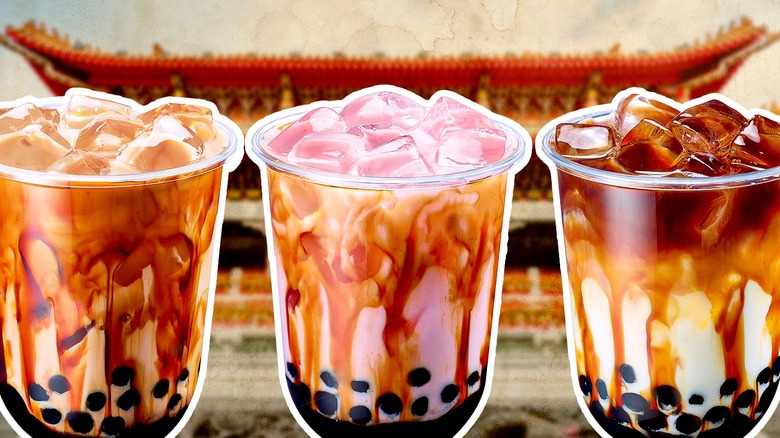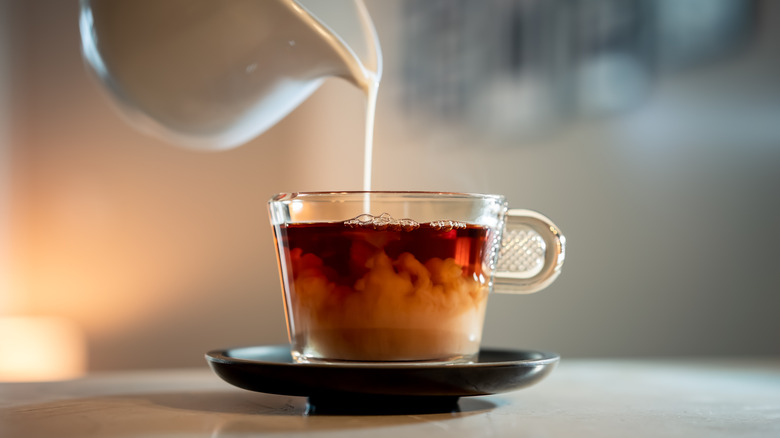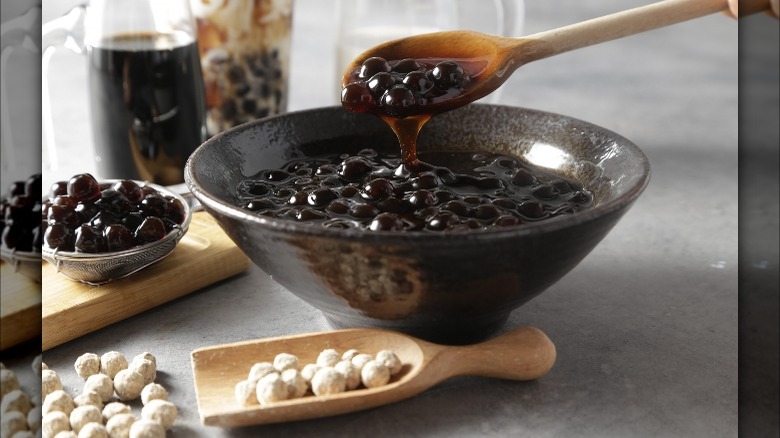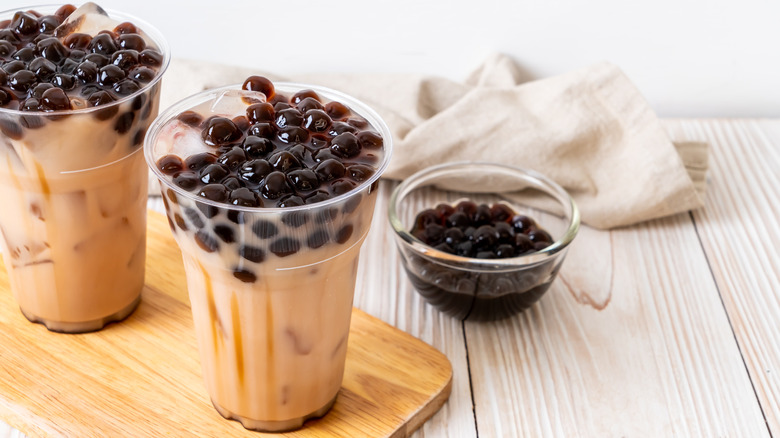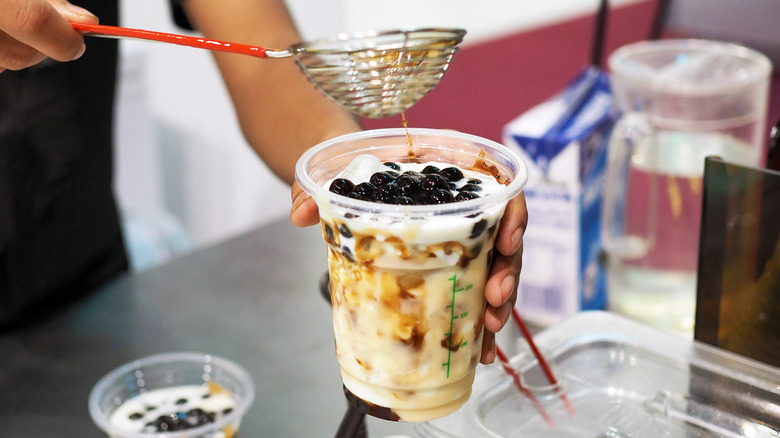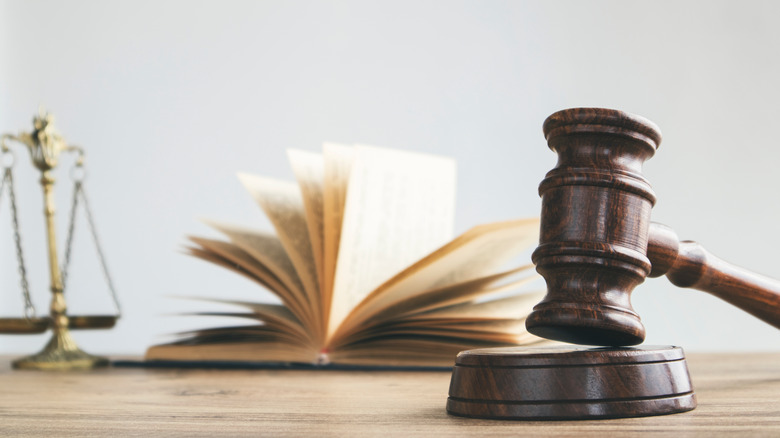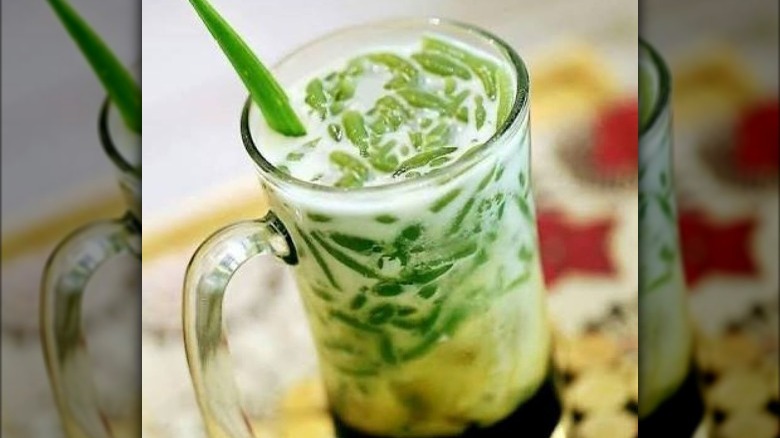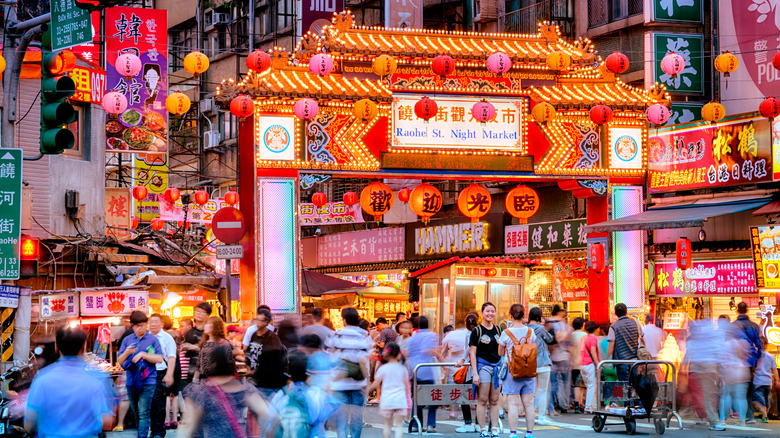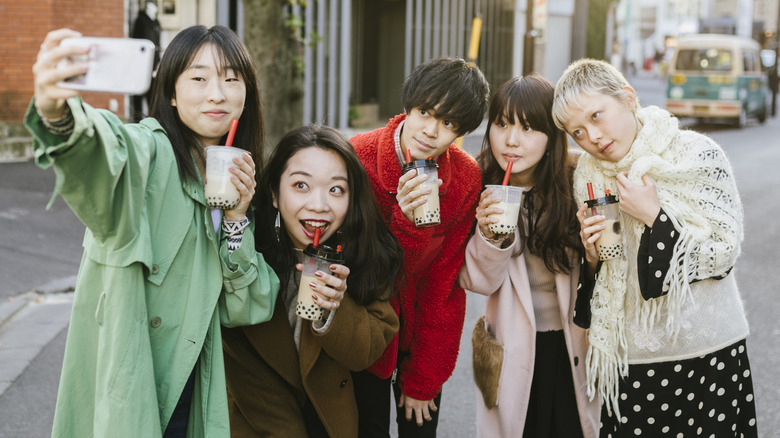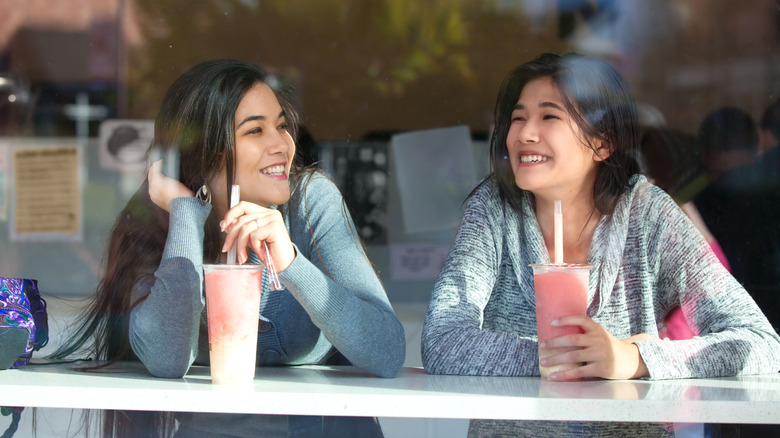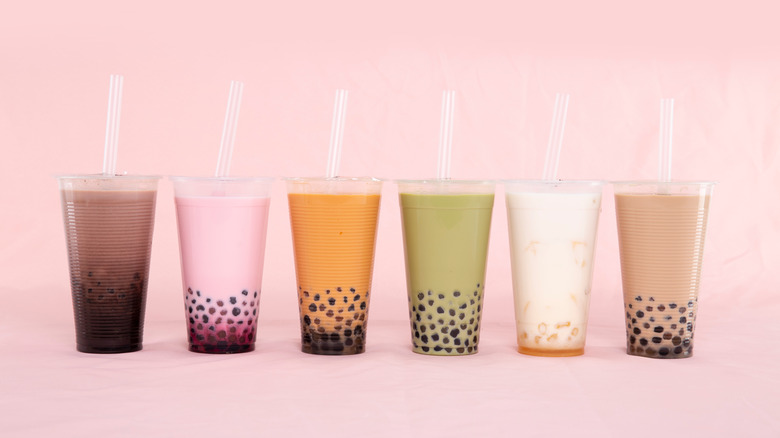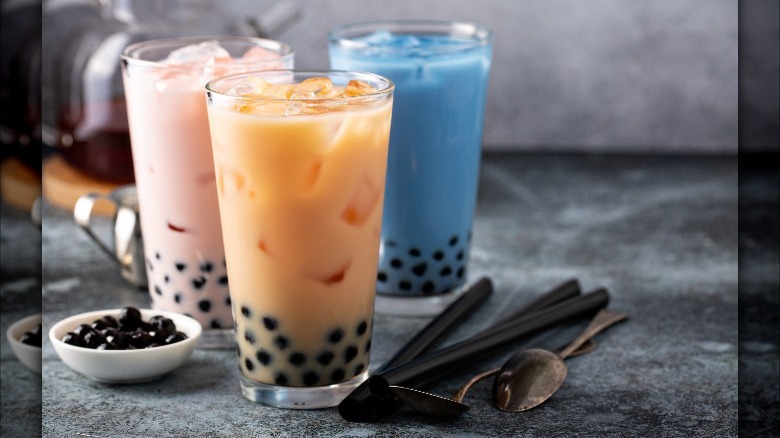The Origins Of Bubble Tea Are Steeped In Mystery
Do you remember the first time you tried bubble tea? As you sipped sweet milk tea and slurped up chewy tapioca balls, you may have even wondered: Who on earth invented such a drink? If you were an instant fan, you were probably just grateful they did. Because whether you call it bubble, boba, or pearl, one thing is for certain: this isn't your average cup of tea.
In its classic form, bubble tea comes with iced black tea, milk (or milk powder), and tapioca pearls. And nowadays, there are a ton of ways to jazz it up, with add-ons like fruit juice, sweet syrups, and jelly candies. Bubble tea has become so popular, you can find it worldwide. But despite its international fame, bubble tea will always be a Taiwanese creation.
Although this tea comes cold, its history is hotly debated. While we know it started in Taiwan, the exact origin is unknown, with some individuals claiming to be the brains behind the beverage. And a lot like the drink, the details are cloudy yet intriguing. To uncover this mystery, we dove into some bubble tea history. We found some juicy details in boba tea's past — and we're here to spill the tea.
So if you've ever wondered how this beloved beverage came to be, keep reading. We'll take you on a journey through time and across continents to learn how this ubiquitous tea developed and what its promising future holds.
Before there was boba tea, there was milk tea
Boba tea would be nothing without its foundation, milk tea. And while tea plants are native to Taiwan, they weren't always used in this fashion.
Both China and Taiwan have a long history of using tea for medicinal purposes. In fact, it was the Chinese who first introduced the rest of the world to the many pleasures of tea. In the 1600s, Dutch merchants traveled to China, returning to their homeland with tea. The Europeans embraced its warming nature and healing properties, and adopted the practice of drinking it themselves. But whether or not they were the first to add milk to tea is up for debate. Because as it turns out, the history of milk tea is also murky.
Some records show that the Chinese began making a "creamy tea" out of butter as early as the 12th century. Once tea became a thing abroad, European traders may have observed this trend and followed suit, replacing butter with milk. However, as we know, trends fall in and out of style, and milk tea is no exception. For a hot second, milk tea fell out of fashion in China. But with increased trade, Europeans eventually reintroduced it, bringing things full circle.
The deep roots of boba pearls
If the chewy boba balls are your favorite part of bubble tea, you're not alone. This crucial addition makes boba tea what it is and even gives the tea its name (well, one of them, at least). "Boba" is actually slang for "champion of breasts" in Chinese. Originally, this nickname was given to the bosomy Hong Kong actress Amy Yip. Along the way, someone must have felt the tea's round pearls also deserved this moniker. And while Taiwanese don't often refer to bubble tea as "boba", it's still commonly called boba in China and on the West Coast of the United States.
These soft, chewy balls are also called tapioca pearls because they're made from the tapioca flour of the cassava root plant. This plant is native to Brazil and likely made its way to Taiwan through Portuguese traders in the 19th century. Another theory suggests that tapioca balls were a gift to Empress Dowager Cixi, who later introduced them to Taiwan. One way or another, merchants started selling tapioca balls, or "fen yuan" in Chinese, at Taiwanese night markets.
Locals, particularly high school-aged kids, fell in love with the texture. This bouncy, gelatinous consistency is revered in Taiwan and even goes by its own untranslatable name, "QQ." Boba satisfies that QQ craving like no other, and people naturally started experimenting with its uses.
Origin theory 1: Chun Shui Tang Tea Room
The most popular origin theory of bubble tea comes from Taichung's Chun Shui Tang Tea Room.
The founder, Liu Han-Chieh, was no stranger to experimenting with tea. As his daughter and Associate General Manager of the shop, Angela Liu, explains," One time he went to Osaka in Japan and saw how hot coffee was turned into iced coffee and thought: 'Why not tea?'...So, when he came back to Taiwan, he'd experienced how to turn hot tea into iced tea using a shaker" (via Taiwan Scene). When beverages are iced, shaken, and poured like this, they form a layer of foam, or "bubbles," on top. Pretty soon, people were calling this iced tea "bubble tea" instead. So "bubbles" is actually in reference to the top layer of foam rather than the boba on the bottom.
Bringing cold tea to Taiwan was a welcome move, especially seeing how hot summers get. Taiwanese people were drinking tea for pleasure more than ever before, enjoying the cool beverage and flavors. Knowing this, the employees of the Chun Shui Tang teahouse were looking for innovative ways to sell more tea. Then, in 1988, an employee named Lin Hsiu Hui brought fen yuan candy to a staff meeting (via CNN). She playfully added these gummy tapioca balls to her cold black tea, and the crowd went wild (well, at that time, it was solely the staff). But once this new tea hit the market, sales soared.
Origin theory 2: Hanlin Tea House
Another well-known origin theory hails from the Hanlin Tea House in Tainan.
Budding entrepreneur Tu Tsong He was just coming off of a failed business venture in 1986 when he decided to open a tea shop. However, he needed to set himself apart to prevent this new business from also going bust. He remembered one of his favorite childhood snacks, fen yuan. And as he described in a CNN interview, "I thought to myself, 'Why don't I add some fenyuan into my green tea.' The white fenyuan looks almost translucent with a white center when brewed inside the golden green tea, much like my mother's pearl necklace. So I coined it 'zhen zhu lu cha' (pearl green tea)." Later, brown sugar or molasses was added to these balls to create a sweeter, darker boba.
However, Tu Tsong He's story doesn't end there. He continues to describe his further contributions to boba tea: "The black bubble tea balls were bigger than the straws the market had then," says Tu. "Our customers had to use spoons to scoop out the tapioca balls. We had to work with a plastic factory to customize straws just for our tea."
The battle of the boba tea creators
These two origin theories are the most well-known across Taiwan, with both tea shops claiming to be the bona fide creator. So much so, in fact, that they went to court to battle it out.
In 2009, the Chun Shui Tang and Hanlin tea shops began suing each other for rights to this beloved beverage. However, both tea shops served milk tea before they served boba tea. And because they also started using tapioca pearls around the same time, it was hard to prove which was first.
Finally, the court came to a verdict in 2019, deciding that bubble tea was a general food item and, therefore, could not be patented (per ET Today). So while we may never know who was the official inventor, it might not matter. After all, both tea shops contributed significantly to the popularization and spread of this well-known Taiwanese drink.
Origin theory 3: Bubble tea as an offshoot of cendol
Just when you thought the origin theories of bubble tea had been laid to rest, we present to you a third contender. Albeit a less popular hypothesis, some people speculate that bubble tea was an offshoot of cendol.
For those unfamiliar, cendol is a Southeast Asian dessert consisting of iced coconut milk with gummy strands made of rice flour or sago. It's popular in Indonesia, Malaysia, and several other Southeast Asian countries, with each region putting its own twist on the refreshing treat. In Java, cendol is also called dawet and is served in a tall glass with a spoon and straw, resembling the colorful bubble teas we know today.
Cendol and bubble tea definitely have their similarities, namely a sweet milky base and gelatinous goodies. Considering the geographical proximity of Taiwan to Southeast Asia, it's possible travelers introduced Taiwan to the thirst-quenching cendol. And with the abundance of tapioca pearls in Taiwanese markets, bubble tea could be a natural replacement.
Mind you, this is all mere conjecture. While nothing can be proved, we wouldn't be doing our due diligence without presenting alternative theories.
Boba tea in Taiwanese night markets
By now, you've heard several references to Taiwanese street markets. These markets sell everything under the sun, which is ironic seeing as they're open from dusk until dawn.
Having existed for over a century, these markets are where tradition meets innovation. Among food stalls, you'll find long-standing Taiwanese staples alongside experimental cuisine. These markets also sell many gelatinous sweets, like aiyu jelly and tofu pudding. We don't know precisely when tapioca pearls entered Taiwan's night markets. Still, they definitely did — and it was in one of these markets that the Hanlin tea shop founder got the brilliant idea of mixing milk tea with these pearls.
As a center of culinary innovation, bubble tea might be the experimental result of night markets. With some vendors selling milk tea and others selling tapioca pearls, it was only a matter of time before they found their way to each other. Even if night markets weren't the birthplace of boba, they definitely helped popularize the trend. And nowadays, you'd be hard-pressed to walk through any night market without finding a boba tea stand.
Bubble tea goes global
Following the origin theories of boba tea, the drink first appeared in the 1980s. But this beverage spread like wildfire in Taiwan, from privately-owned shops to nationwide chains. According to the Taiwan Gazette, by 1993, there were approximately 5,000 bubble tea shops in the country. But the boba tea craze wasn't confined to the island.
Bubble-mania soon hit other Asian countries like Singapore, Malaysia, Japan, Hong Kong, and China. And thanks to a massive wave of Taiwanese immigrants, boba tea made its way Stateside in the '90s as well. At first, bubble tea was added to larger menus in Taiwanese-owned restaurants. Eventually, shops dedicated solely to boba started to spring up.
Wherever the Taiwanese diaspora hits, bubble tea follows. These days, you can find this refreshment everywhere, from Asia and Africa to the Americas. And while it holds a special place in Asian Americans' hearts, it's become far more mainstream than anyone could have imagined.
Boba culture in the United States
The 2013 music video for "Bobalife" gives us a window into America's boba culture. In this humorous video by Taiwanese American rapper and comedic duo Fung Brothers, young Asian Americans walk the streets of sunny California with bubble tea in hand. They frequent boba shops instead of Starbucks and swap booze for boba. While the song pokes fun at the bubble tea obsession, there's truth in its lyrics, "It's Chinese culture to stay with a cup of tea. We updated to pearls and sealing machines...The new drink of all the young Asians...You can call us the boba generation."
Young adults of East Asian descent comprise the largest population of boba drinkers (per Pearl Lemon Boba). And boba may have helped this generation connect with their heritage. Since the early aughts, boba tea has been seen as hip, and social media reinforces this. With the aesthetically pleasing nature of boba, the Instagram hashtag #bubbletea has over 3 million posts alone.
While it may have started as an Asian American trend, it quickly bubbled over to the general population. Even mainstream news outlets like the New York Times reported on the tapioca pearl shortage of 2021, which sent boba fans into a tizzy. Despite those temporary shortages, boba tea's increased popularity and globalization could be a good thing. Not only does it provide cultural connectivity, but it can also encourage curiosity to learn more about East Asian culture.
The evolution of boba tea flavors
Bubble tea comes from humble beginnings, but has evolved into an international phenomenon. In its original form, this drink has five simple ingredients: black tea, milk, sugar, tapioca pearls, and ice. While the OG version still exists, bubble tea options have expanded significantly, with wacky flavors and exquisite color combos.
Currently, nothing is off the table when it comes to bubble tea, from boba tea ice cream floats to coffee cocktails. Gong Cha in Singapore even partnered with Heinz to make a tomato bubble tea, serving it straight out of ketchup bottles.
The choices are endless, and boba tea is known for being customizable — which is part of its allure. When ordering bubble tea, you'll need to make a series of decisions that may cause analysis paralysis, from the type of tea and milk to different gummy add-ins like aloe or grass jelly. The upside to this? If you know exactly what you'd like, you can have it tailor-made on the spot. Those with dietary restrictions will be happy to know they can order their tea dairy-free, gluten-free, or caffeine-free. But if you find all this decision-making exhausting, save yourself the headache and opt for a preset classic, like black tea milk.
A Taiwanese icon
While the history of bubble tea might be steeped in mystery, one thing is certain: it's a Taiwanese creation. Bubble tea has become so synonymous with Taiwan that government officials even toyed with the idea of putting it on their official passport cover. Unfortunately, the bubble tea design didn't make the final cut, but the tea itself continues to be a powerhouse internationally.
The tea is a symbol of the country's culture and ingenuity. It's also a means to promote Taiwan's soft power abroad. Bubble tea is fun, sweet, and delicious, which is why many people develop a positive correlation between this drink and the country it came from.
But not all gastrodiplomacy is so lighthearted. In an interview with Al Jazeera, Po-Yi Hung, an associate professor at National Taiwan University, describes, "We Taiwanese people always have been somehow trapped in the kind of anxiety of our national identity, and bubble tea has become a kind of symbol for the world to see the existence of Taiwan."
It's this uncertainty that spurred Taiwan's connection to the Milk Tea Alliance, a democratic movement belonging to Asian nations fighting for independence. This alliance includes Hong Kong, Taiwan, Thailand, and Myanmar, among others. Not only do these parts of Asia share similar political goals, but they also share a love of milk tea. Although each country's milk tea is slightly different, it's become a symbol of their joint struggles.
The future of bubble tea
With an official bubble tea emoji and a National Bubble Tea Day, this beverage has solidified its place in the international food scene.
It's safe to say bubble tea isn't going anywhere anytime soon, and the future of this beverage looks bright. The boba tea industry is estimated to grow at an annual rate of 7.8%, and will surpass $4 billion by 2027 (per Allied Market Research).
So what will boba tea look like in the future? It's hard to say. We highly doubt that the original creators could've predicted just how successful their tea would be. But as we move toward the future, we know we're taking bubble tea with us. And we suspect it will adapt to the times, just as it always has. Perhaps bubble tea shops will begin catering to more health-conscious consumers and incorporate more technology or sustainability practices. We're fairly certain, though, that this beloved bubbly beverage will continue to be around for tomorrow's tea enthusiasts to enjoy.
